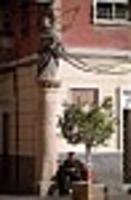

You probably know this already, but it’s pretty sunny here in Spain, particularly in Murcia and Almería. For gardeners on anything but the smallest scale, that’s a problem.
You only need to glance into the newsagents here these days and the chances are that the headlines are about water, or the lack of it. Farmers, in particular, are taking the brunt of the war for water (although somehow the property developers always seem to find a supply for that new golf course…). The desalination plants make water that costs them at least four times that which farmers in other regions have to pay. Drip irrigation is how all farmers around here make the best use of this most precious resource. Drip irrigation can be useful for your garden and smallholding too! Since your water will be on the meter here, you too will be looking for ways to save water. Not only can drip irrigation save water, it can save you time and also keep your plants alive when you’re away from home.

The first part of making drip irrigation system is design. Plan a route for a ‘main line’: from the water tap and around the garden. This will be a semi-flexible black plastic pipe which 25mm (an inch) diameter. You can bury it under garden paths so you won’t be tripping over it, but you’ll want to run it on the surface near the plants themselves. The reason for running it on the surface is that you will be wanting to tap into it to add ‘fingers’ of smaller diameter, more flexible tube that takes water to individual plants or groups of plants. At each tree, or group of plants, you will attach a ‘dripper’ (or ‘emitter’ for the technical term) or a tiny sprayer (dripper for trees and large shrubs, spray for herbs, etc).
Special consideration needs to be taken if you are planning to feed the irrigation setup by gravity (from a water butt from your gutter downpipe or from a tank of irrigation water). Firstly, since your water is not coming directly from a drinking water quality tap, a filter is even more important than ever. Secondly, you will need ‘pressure compensating’ emitters. These cunning widgets give out the same amount of water, practically regardless of the pressure in the supply pipe. They are rated in terms of litres per hour (for example 4 l/h), usually embossed on the emitter itself. They really aren’t much more expensive than other emitters, so it’s probably worth using them in all installations anyway since they also get around other problems (like friction losses causing differences in pressure as the water moves from the beginning to the end of the system).

Finally, you will need some kind of head on the water, the more the better, so if you can make sure that there is at least a metre, preferably a couple of metres of head between the bottom of your tank and the first emitter, the system should work well. You can achieve this by putting the tank up on concrete blocks.
Irrigation – riego
Drip Irrigation - riego por goteo
Dripper / Emitter - goteo / emisor
Pressure Compensating – autocompensante
PE – politeleno
Tank – deposito
Tube – tubo/tubería
Hose – manguera
Filter - filtro
Elbow – codo
Tee – te
Coupler – manguito
Stop cock / gate valve – llave de paso
End stop – tapón
Big white cube thingys – cubo de mil litros de segunda mano (para hacer un deposito de agua de riego)
You will need some tools, a saw (just about any saw, hacksaw, ripsaw, whatever) for cutting the tube, a pair of pliers for pushing the fittings into the tube, a pair of pipe grips for doing up the fittings on the thicker tube (unless you have hands like a gorilla) and, more specialised, hole punches for puncturing the tubes (different sizes depending on whether you are teeing off from the main line into the fingers or you are adding drippers to the finer tube itself).

As for materials, let’s start from the tap and move on to the tree. You may need an adaptor for your tap to get on to the tubing. Then it’s a good idea to add a timer-valve. These can cost a few bob to start off with, but once you have left the tap on overnight a few times, or come back from a trip away to find a scorched garden, you’ll be glad you bought one. Next, you’ll need a filter so your drippers don’t clog up. Then you’ll need the 25mm polyethylene (PE) pipe and at least one end-stop. You may also want some tees. You can buy the 25mm PE pipe by the metre; if the shop insists you buy a roll of 100m go elsewhere for your pipe. The same goes for the 12mm PE pipe you will need for the ‘fingers’.
You will need some inserts (for want of a better word) that let you plug the 12mm pipe in as a ‘T’ to the 25mm pipe. At the ends of the 12mm pipe, you will need end stops (very simple affairs that you just stuff in the open end). You will need drippers / sprayers. Your design will dictate how many of which type. Finally you should buy a few ‘goof plugs’ (as the Americans call them) that you can use to plug holes that remain when you change your mind / garden layout (or, as their name implies, you goof and put a hole in the tube where there shouldn’t be one!).
These materials are cheap; the 25mm tube is about €0.30 a metre, the 12mm tube is about €0.10 a metre, the drippers are about €0.25 each, 25mm tees around €1.50, 25mm end plugs about €1 each and about €0.05 for the 12mm end plugs. The only things that are ‘pricey’ are the timer valve (can be had for as much as €100, or as little as €20, so worth shopping around) and the filter – around €10. Go to another shop if they are asking much more than this.
If you are making a gravity-fed system you will need a water tank. We found that the white, metal-caged, thousand litre, metre-square plastic cubes (as seen all over the countryside!) that are second-hand containers from ‘orrible things like hydraulic oil are perfect. You should pay about €50 each, plus delivery charges (handy if you have a trailer for your car, because the delivery can be expensive!).
You will need to get rid of the remaining gunk that was shipped in the container (usually still has a label on the side so you know what you are dealing with). Then a good dose of washing up liquid, some coarse gravel, a few buckets of water and a helping hand to roll the cube around will clean out the insides.
You will need to cover the cube up, not just because they are unsightly, but UV rays from the summer sun will destroy the plastic when the cube isn’t completely full of liquid. Black plastic sheeting (to stop the UV) covered by hessian (to look pretty) should do the job.

You will need to connect the cube’s tap to your irrigation pipework – for this you will need a special fitting that comes from a drinking water container – your fereterría or almacén should know the problem well since the thread on the tap is ‘weird’ but it’s a common problem. The special fitting usually needs some extra-thick PTFE tape or hessian and plumbers mait to stop it leaking. Don’t complain – the special fittings only cost a Euro or so – if you want one that’s made from turned aluminium, specially made for the job, they cost more like €25 each.
Good luck!
By Marcus & Debbie Jenkins
Taken From “A Brit's Scrapbook: Going Native In Murcia”